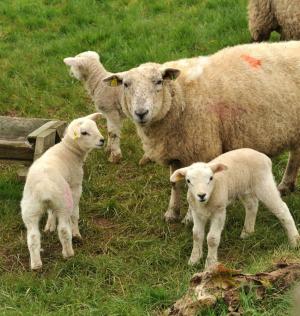The Agri-Food and Biosciences Institute (AFBI) Veterinary Sciences Division wishes to advise sheep farmers of the likely risk of Nematodirus worm infection in young lambs occurring at this time of year.

Nematodirus infection results from the ingestion of large numbers of infective worm larvae present on contaminated pasture. Lambs grazing the same pasture in the previous year were the source of this contamination. For Nematodirus eggs to hatch they must experience a period of cold weather followed by warmer conditions. These conditions are usually achieved during the winter and spring of each year.
Nematodirus eggs passed out by lambs in 2017 will generally have remained unhatched on the ground throughout the winter season. Given suitable conditions of moisture and temperature, they will undergo mass hatching in the spring of 2018, resulting in a high risk of infection for lambs. Affected lambs develop profuse scour and can die rapidly.

Hatching of Nematodirus eggs has commenced in 2018 and current meteorological readings indicate that peak hatching will take place during the last week of April.
Nematodirus normally only affects lambs between 6 and 12 weeks of age and clinical signs usually appear two weeks after ingestion of large numbers of larvae. Although rare, Nematodirus infection can occasionally cause problems in young calves. Therefore, farmers should be on the alert for signs of scour in lambs (and possibly young calves at grass) from May onwards.
Farmers should be aware that Nematodirus infection might be confused with coccidiosis, another disease which can cause severe scour in young lambs. As the treatments for Nematodirus infection and coccidiosis are different, accurate diagnosis and treatment recommendation, through your veterinary surgeon, are essential.
Nematodirus disease can be avoided or reduced in lambs by:
- not grazing lambs on the same fields as those grazed by lambs of a similar age last year.
- using anthelmintic drenches every 2 to 4 weeks. The interval between doses depends both on the particular anthelmintic used and the severity of infection. To date, only limited evidence has been found of drug resistance in Nematodirus to any of the available classes of anthelmintic.
Your veterinary surgeon should be consulted at an early stage. He or she is in an ideal position to provide advice on the prevention and /or treatment strategy best suited to your particular circumstances. AFBI’s Veterinary Sciences Division can test faeces samples from sheep or cattle to determine the level of worm eggs present. A minimum of 5 grams of faeces from each animal is required for this test.
Notes to editors:
- AFBI carries out high quality technology research and development, statutory, analytical, and diagnostic testing functions for DAERA and other Government departments, public bodies and commercial companies.
- AFBI's Vision “Advancing the Local and Global Agri-Food Sectors Through Scientific Excellence”.
- All media enquiries to AFBI Press Office
Latest news
- AFBI issues Nematodirus warning – Spring 2025 11 April 2025
- Managing Nature Based Risks to the UK Economy and Opportunities for Green Finance 08 April 2025
- The Omics Days Conference 27 March 2025
- AFBI Hillsborough host AERA committee 27 March 2025
